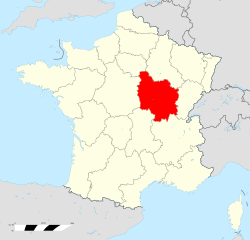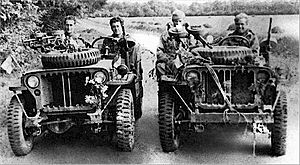Operation Houndsworth facts for kids
Quick facts for kids Operation Houndsworth |
|||||||
|---|---|---|---|---|---|---|---|
| Part of Western Front | |||||||
 Map of France, the Burgundy region is highlighted in red |
|||||||
|
|||||||
| Belligerents | |||||||
| Commanders and leaders | |||||||
| Strength | |||||||
|
Unknown | ||||||
| Casualties and losses | |||||||
| 10 Killed 8 Wounded |
132 Captured 220 Killed or wounded 6 trains derailed 70 vehicles destroyed |
||||||
Operation Houndsworth was a secret mission by the British Special Air Service (SAS) during World War II. This operation took place between June 6 and September 6, 1944. It focused on the area around Dijon in the Burgundy region of France. The main goals were to stop German supplies and troops from moving. They also helped coordinate the French Resistance fighters. This was important to prevent German reinforcements from reaching the Normandy beaches. A key target was the 2nd SS Panzer Division Das Reich.
Contents
What Was the Special Air Service (SAS)?
The soldiers involved in Operation Houndsworth were part of the Special Air Service Brigade. The SAS is a special unit of the British Army during the Second World War. It was created in July 1941 by David Stirling. At first, it was called "L" Detachment, Special Air Service Brigade. The "L" was a trick to make the enemy think there were many such units. The SAS was designed to be a commando force. Its job was to work behind enemy lines, especially in the North African Campaign.
In 1944, the Special Air Service Brigade was formed. It included British, French, and Belgian SAS units. Their mission was to parachute behind German lines in France. From there, they would support the Allied forces as they advanced through Belgium, the Netherlands, and into Germany.
Why Was Operation Houndsworth Important?
In May 1944, the Allied leaders at Supreme Headquarters Allied Expeditionary Force (SHAEF) gave the SAS Brigade two important missions in France. One was Operation Houndsworth near Dijon. This mission was given to 'A' Squadron of the 1st Special Air Service. The other was Operation Bulbasket near Poitiers.
Both operations aimed to stop German reinforcements from southern France. These troops were trying to reach the Normandy beaches. The SAS would destroy supply depots and block railway lines. They especially wanted to delay the 2nd SS Panzer Division Das Reich. This German tank division was based near Toulouse. Experts believed it would take this division three days to reach Normandy. The SAS's job was to make that trip much longer.
The Mission Begins

Operation Houndsworth involved 18 officers and 126 soldiers from 'A' Squadron, 1st Special Air Service. A small group of SAS scouts landed in the area on June 6, 1944. The rest of the squadron, led by Major Bill Fraser, followed on the night of June 10/11, 1944. They also parachuted in several Jeeps. These Jeeps were armed with powerful Vickers K machine guns. The squadron set up a hidden base in the mountains and forests southwest of Dijon. This area was in the Monts du Morvan in the Nièvre department.
The SAS later expanded their work further south near Dijon. This was part of Operation Wallace. This new operation helped take some pressure off Operation Houndsworth.
What the SAS Achieved
The SAS squadron carried out many successful attacks. They blew up the main railway line between Lyon and Paris 22 times. After one attack, a member of the French resistance talked to the workers repairing the tracks. He asked how long the repairs would take. When the workers realized he was helping the resistance, they gave him advice. They even drew him a map showing where to cause more damage next time!
The squadron also caused many losses for the Germans. They killed or wounded 220 German soldiers. They captured 132 prisoners of war. They also found 30 targets for the Royal Air Force to bomb from the air.
However, the SAS also suffered losses. During the operation, eight of their men were wounded, and ten were killed. Because of the SAS's success, the Germans attacked local villages in revenge. The people of Dun-les-Places, Montsauche-les-Settons, and Planchez suffered greatly. Many residents were murdered during these German attacks.
A Close Call and the End of the Operation
The Germans eventually found out where the SAS camp was located. They planned a surprise attack for August 20, 1944. But the French resistance knew about the attack. Corporal David Danger of the SAS managed to get through the German lines. He warned the squadron about the coming attack. Because they were warned, the SAS fought off the Germans.
Operation Houndsworth ended in September 1944. Corporal Danger received the Military Medal on March 29, 1945. He was honored for warning the camp and for keeping radio contact with Allied forces for four months.

